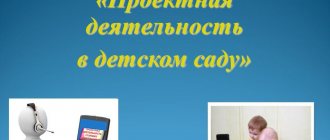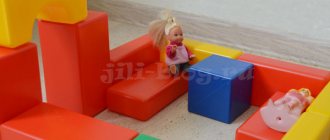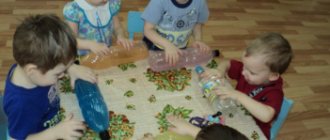Construct OD: “Observing seasonal changes in nature while walking”
Construct
PM 03 Organization of classes in basic general education programs of preschool education
Chernoskutova Marina Vladimirovna
Age group:
second youngest (3-4);
Educational area:
“Cognitive development”, “Socio-communicative development”, “Speech development”;
Type of OD:
organizing a walk;
Subject:
“Observation of seasonal changes in nature”;
Activities:
cognitive, labor, communication, play, motor;
Form of organization:
frontal, individual;
Target:
development of cognitive activity in the process of observing seasonal changes.
Planned results:
Children show respect for nature;
Children show a desire to listen to the teacher.
The children have friendly relations and organize a gathering.
Children demonstrate the ability to notice seasonal changes in nature.
Children demonstrate observation, memory, attention, and imagination.
Children have ideas about the signs of autumn.
| TASKS taking into account the educational program | TASKS taking into account the individual characteristics of children |
| Educational tasks: Foster a caring attitude towards nature. To cultivate in children a desire to listen to the teacher; Foster friendly relationships between children, organize gatherings. Developmental tasks: Develop the ability to notice seasonal changes in nature. develop observation, memory, attention, imagination, activate vocabulary. Training tasks: Form children's ideas about the signs of autumn. |
Principles of preschool education (FSES):
1) building educational activities based on the individual characteristics of each child, in which the child himself becomes active in choosing the content of his education, becomes a subject of education (hereinafter referred to as individualization of preschool education);
2) assistance and cooperation of children and adults, recognition of the child as a full participant (subject) of educational relations;
3) supporting children’s initiative in various activities;
4) the formation of cognitive interests and cognitive actions of the child in various types of activities;
5) age adequacy of preschool education (compliance of conditions, requirements, methods with age and developmental characteristics).
Principles of education:
formation of a personal style of relationships with peers and teachers; creating a positive emotional background and an atmosphere of emotional uplift; education through interaction.
Principles of training:
principle of accessibility; principle of visibility; the principle of systematicity and consistency; scientific principle; principle of consciousness; principle of activity.
Observation and observation
Topic No. 3: Observation and observation.
Purpose of the lesson: to introduce the research method - observation. Getting to know the basic research methods available to us (think for yourself, ask another person, observe, conduct an experiment, etc.) while studying available objects.
Objectives: Cognitive UUD: - learn to obtain new knowledge from different sources, find answers to questions, using your life experience and information received in class; - introduce students to the concept of observation, observation, their application in their own research; - develop cognitive activity, curiosity when conducting experiments, the ability to draw conclusions, the ability to think analytically: classify, compare, generalize; — introduce the basics of using information technology in research activities.
Regulatory UUD: - set educational tasks based on the correlation of what is already known and what is not yet known; - direct children to identify the main and secondary from this information.
Communicative UUD: - creating a favorable successful situation in the classroom; - the ability to formulate one’s thoughts orally, listen and understand the interlocutor - to develop experience in public speaking, to contribute to the formation of a culture of speech; - formulate your own opinion and position; jointly agree on the rules of behavior and communication in pairs or groups; - ability to interact during work.
Personal UUD: - ability for self-assessment based on the criterion of success in research activities. Equipment: presentation, cards for working in pairs, magnifying glasses.
Progress of the lesson.
1. Organizational moment.
Guys, stand in a circle. Smile at each other. Our eyes (we put our palms to our eyes), our ears, our head, our heart are open to knowledge. Share your warmth with each other. Now we are a team. We have to work hard today and learn something new.
2. Updating basic knowledge - Today in class we continue to be researchers. - Remember who researchers are. (People engaged in scientific research.) - What is research? (Scientific work.) - Today you and I will take another step into science. Look carefully at the cards with symbols - What do you think they are telling us? (This is an image of research methods.) - Remember these methods. (Think, ask yourself a question, ask another person, conduct an experiment, look in books, look on a computer, watch on TV.) - What is the first and main method used by the researcher? (Think for yourself) - Of course, before you start research, you first need to think for yourself. What do you think this question mark means? (There should be a new research method here) - What do you think will be discussed in our lesson? (About a new research method) - Correct! But you can guess which one for yourself. - What are your assumptions? (Observation and observation.) - What is observation? What about observation? — Which known method can you use in class to answer these questions yourself? (look in books - encyclopedias, explanatory dictionaries) - Let's find the meaning of these words in Ozhegov's explanatory dictionary. Observation develops in the process of various types of activities, which, for their successful implementation, require the ability to purposefully perceive - look, listen, touch - What synonym is suitable for the word observant? - (Attentive) - Now let’s check how observant (attentive) you are.
Exercise No. 1 “Find the difference.” Look at the pictures and find how they differ from each other. Exercise No. 2 “Shadow” Find the shadow of the picture and draw a line. Exercise No. 3 “Aquarium”. Observe, determine in which 3 squares the fish are never repeated. Exercise No. 4 “Use only touch”
The game is played with eyes closed. a) Identify the object while wearing thick mittens. b) Identify objects by moving a short stick or match along them. c) Having received 10 coins in your hands, quickly determine their amount. d) From a stack of books, choose the one that the presenter names. e) Knowing how many pages there are in the book, open it on the indicated page. f) By feeling the thickness of one sheet, several sheets, and all sheets in a book, determine approximately how many pages there are in it.
Exercise No. 5 “Learn without seeing” Children who know each other well (no more than 10) gather together. Two blindfolded drivers compete with each other to see who recognizes the largest number of guys who approach them. You can use no more than two methods each time, for example, shaking hands, feeling your shoulders, touching your head, whispering, coughing. The one who recognizes a friend in this way gets one point.
Exercise No. 6 “Recognize by sound” The players sit with their backs to the leader. The latter produces noises and sounds with various objects. The one who guesses how the leader produces them raises his hand and, without turning around, tells him about it. The presenter can throw various objects on the floor: a spoon, an eraser, a piece of cardboard, a pin, a ball, etc.; can hit an object with an object, leaf through a book, crumple paper, tear it, tear material, rub hands, comb hair, wash hands, sweep, plan, cut, etc. The one who points correctly more times than the leader makes sounds , is considered the most observant.
IV. Homework If desired, conduct experiments with pets at home. These could be cats, dogs or budgies. You can create a matrix for the experiment. Find out: • How does the animal react to sharp gestures, affectionate words, rude calls? You can draw a picture and we will discuss your findings in the next lesson.
Observation No. 1 “Hamster House” Observation No. 2 “What is he eating?” “How is he eating?” Observation No. 3 “How is your rest?” Observation No. 4 “How is a hamster different from a mouse?” Observation No. 5 “How does he move?”
V. Summary of the lesson. Reflection What will you tell us about our lesson at home today? What research methods were used? Now guys, stand in a circle. Hold hands. Thank each other for working together. Now take the emoticons that are on your table. On the board you see three little men. Evaluate your work.
Thanks for the lesson, see you again guys.




